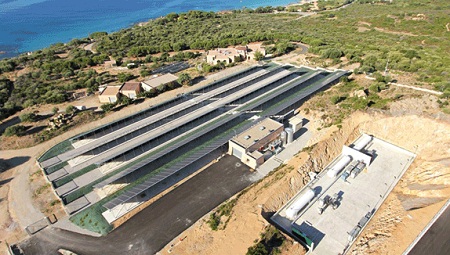We ought to know, in a few short years, whether using wind and solar to create hydrogen is a viable clean-energy storage technique. Projects keep popping up all over the place – the latest just this month in Corsica – providing plenty of opportunities to gather data, examine the numbers, tally the costs and see what’s what.
Details on the Corsica project are not plentiful. The press release put out by the French conglomerate Areva is full of holes and the translation to English is a little rough. But this key sentence says the project, at a University of Corsica site in Vignola, consists of a “560 kWc (kilowatt capacity) photovoltaic power plant … connected to an innovative energy storage system developed by Areva, made of an electrolyzer, hydrogen and oxygen reserves, and a fuel cell.”

Technically speaking, that’s all we know. Scouring the Areva website reveals little more than vague background. But this “MYRTE platform” of Areva’s sure sounds a lot like the projects we’ve seen in Germany – both in Herten and Prenzlau – as well as a more recently announced project on Long Island, N.Y. Those projects all involve using wind power as the energy source, instead of solar, but the basic idea is the same: a clean source of energy is used to run an electrolysis unit to produce hydrogen gas from water. The hydrogen can then be used in any number of ways, including in a fuel cell, as a power source.
Areva said that the Corsica project – clearly small, at 560 kW – “aims to demonstrate the feasibility of a solar energy storage solution using hydrogen technologies to mitigate the fluctuations of solar power generation, and contribute to securing Corsica’s power grid.”
And if it works out well? Areva said it is eager to push the technology further.
“The MYRTE platform allows us to get out of the laboratory and test our technology in a real environment,” said Jerome Gosset, a VP in the company’s hydrogen and energy storage division. “It is our first installation at this maturity level, connected to the electricity network. This day is the beginning of a new chapter for the BU: we will now on be in operational exploitation of such systems.”

The driving force behind these efforts is the need to match energy supply and demand, a task that becomes more difficult for grid operators as renewables, with their variability in production, become a bigger part of the mix. For solar, storage could help a system maintain steady performance even if clouds obscure the sun briefly, or could even extend power production into the evening hours, when solar radiation begins to fade but demand is often high.
With wind, a frequent problem is that production surges late at night, when demand is low. Pumped storage is one way of storing such energy for later use – the wind power is used to move water up a hill, where it can stored, and then released as needed to create energy by driving turbines as it comes down the hill. But there are geographic and transmission hurdles to come with this technique, and fuel cells could offer greater flexibility.